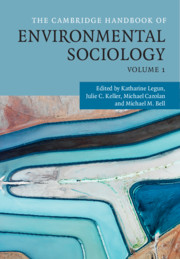Book contents
- The Cambridge Handbook of Environmental Sociology Volume 1
- The Cambridge Handbook of Environmental Sociology
- Copyright page
- Contents
- Figures
- Tables
- Contributors
- Foreword
- Introduction
- Part I Theory in Environmental Sociology
- Part II The Economy and Environmental Sociology
- 6 Material Worlds: Understanding the Relationship of Capital and Ecology
- 7 Green Economies and Community Wellbeing
- 8 Beyond the Limits to Growth: Neoliberal Natures and the Green Economy
- 9 The Ecosocialist Alternative
- 10 Commons, Power, and (Counter)Hegemony
- 11 Emplacing Sustainability in a Post-Capitalist World
- Part III Culture and Environmental Sociology
- Part IV Politics, Power, State
- Part V Social Justice
- Index
- References
8 - Beyond the Limits to Growth: Neoliberal Natures and the Green Economy
from Part II - The Economy and Environmental Sociology
Published online by Cambridge University Press: 05 November 2020
- The Cambridge Handbook of Environmental Sociology Volume 1
- The Cambridge Handbook of Environmental Sociology
- Copyright page
- Contents
- Figures
- Tables
- Contributors
- Foreword
- Introduction
- Part I Theory in Environmental Sociology
- Part II The Economy and Environmental Sociology
- 6 Material Worlds: Understanding the Relationship of Capital and Ecology
- 7 Green Economies and Community Wellbeing
- 8 Beyond the Limits to Growth: Neoliberal Natures and the Green Economy
- 9 The Ecosocialist Alternative
- 10 Commons, Power, and (Counter)Hegemony
- 11 Emplacing Sustainability in a Post-Capitalist World
- Part III Culture and Environmental Sociology
- Part IV Politics, Power, State
- Part V Social Justice
- Index
- References
Summary
Since the 1980s, environmental governance has seen the embrace of market-based instruments for managing all manner of environmental problems, from water shortages to overfishing, climate change to biodiversity loss. This turn to the market recalls the arguments and techniques of liberal political economy, with its focus on the market, private property, and individual self-interest as the best means of securing efficient allocation of resources. This has led scholars in environmental sociology and related fields to talk of the “neoliberalisation of nature.” This chapter aims to achieve two things: first, to draw out and examine the continuities and discontinuities between classical liberal formulations of the problem of scarcity and the neoliberal green economy. Second, to demonstrate the importance of combining Foucault’s later work on liberalism and biopower with Marxist critiques of capitalist political economy. The main takeaways of this chapter are for environmental sociologists to be cognizant of, and better able to account for, the historic shifts that have taken place since the 1960s. Neoliberalism is a political project that has since the 1970s sought to absorb and regulate the force of radical environmental social movements.
- Type
- Chapter
- Information
- The Cambridge Handbook of Environmental Sociology , pp. 124 - 142Publisher: Cambridge University PressPrint publication year: 2020
References
- 2
- Cited by



